In this guide, we’ll lay out step by step everything you need to do to create a B2B Seo strategy to drive both traffic and most importantly leads through your website.
Organic search traffic is essential for tech B2B organisations regardless of their key marketing goals – increasing awareness, positioning as a thought leader or driving marketing qualified leads. Unlike paid search, organic search underpinned by a systematic SEO strategy yields ongoing dividends over time and facilitates engagement with audiences who already have an intent to seek further information about the brand or topic.
In this guide, you will learn the key aspects of a B2B SEO strategy that can deliver ongoing traffic to the website and consistent marketing qualified leads.
Time and effort wisely spent on SEO pays rich dividends over time: this guide will analyse three B2B brands who are reaping the benefits of a strong SEO strategy: Zapier, HotJar, and Campaign Monitor.

This really is a complete guide to creating a B2B SEO Strategy, so if you wish to jump to specific sections please use the contents table.
What is B2B SEO?
B2B search engine optimisation (SEO) is a digital marketing strategy aimed at increasing organic search engine positions for target keywords in search engines such as Google or Bing. B2B SEO tends to focus on keywords that key decision-makers or influencers will be searching for whilst at work.
For any B2B company, SEO is one of the few sustainable ways to create an audience, generate leads, and, ultimately, close customers. More than 70 percent of B2B researchers start their buying process with a generic search. Added to this, research from HubSpot found that 61% of B2B marketers say SEO and organic traffic is their top inbound marketing priority and they plan to dedicate “substantial marketing budget” to it.
Your target customer will be researching and finding potential suppliers via search engines, and your competitors are most likely investing into SEO with strategies in place. It doesn’t matter if you’re an established player in your market, or if you’re marketing for startups, SEO can be a game changer for your business if done correctly.
SEO for a B2B organisation needs to be well researched, implemented with an eye on quality, and sustained over time.
The difference between B2B and B2C SEO
While there are some fundamental similarities, the principles of SEO for B2B brands are different to those of B2C brands.
To elaborate further: when it comes to Google’s actual ranking factors, SEO in B2C is exactly the same as B2B. In other words: there’s no “B2B algorithm”. There are no special widgets or plugins that B2B brands need to rank in Google and same SEO best practices that apply to B2C also apply to B2B.
One other similarity is the fact that if you have a problem or you need to learn about something chances are your first point of call is Google: 89% of B2B researchers use the internet to gather information about purchases with 90% of them using search engines (Google, Bing etc) to do so. This is exactly the same for B2B and B2C.
But that’s where the similarity ends. In practice, B2B SEO IS different to B2C, in the following ways:
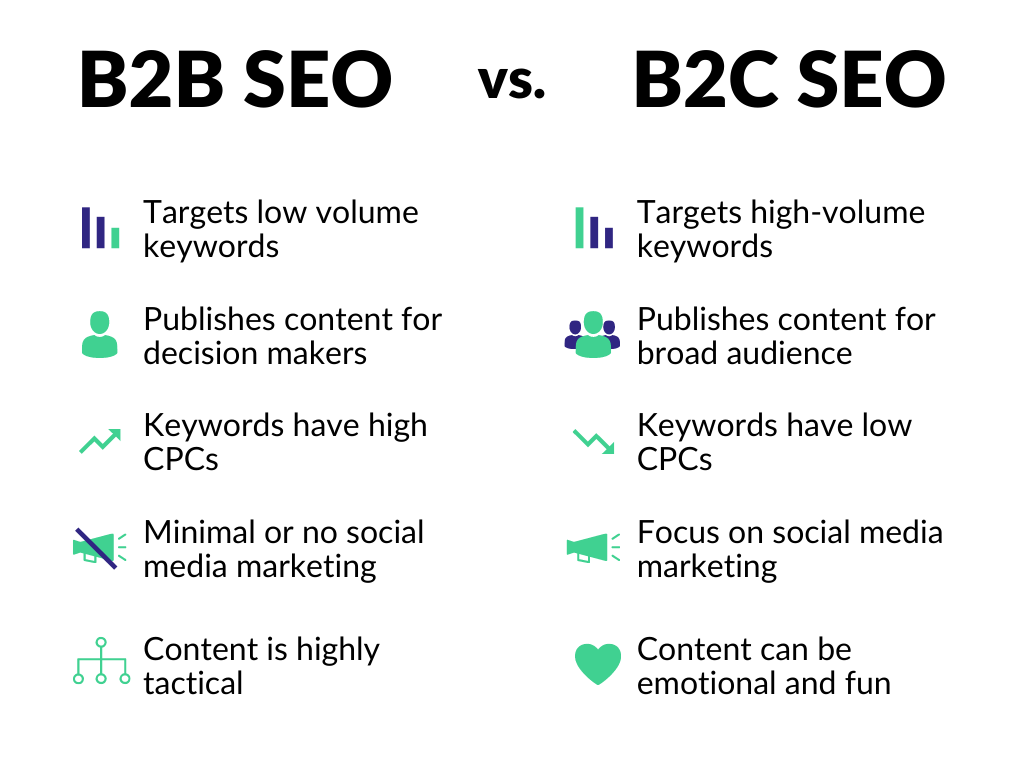
To elaborate on some of the points above: within B2C your target market will typically be a broad demographic group (like “new parents” or “people that want to lose weight”). These people will be searching for very generic keywords that will have huge volumes.
For example “how to lose weight” has an average monthly search volume of 60,500.
B2B brands are typically targetting a much smaller group of decision makers. At Isoline, we’ve often had strategic meetings with clients who tell us that they want to laser-target a small group of under 1,000 decisionmakers and influencers in specific companies globally. For example, ‘e-commerce managers and customer experience leads among kitchen retail companies around the world’.
This is where the biggest difference is.
For a B2B SEO strategy, it is often worth your while to target keywords that get just 50 searches per month. Or – in some cases – even 10.
B2B SEO Strategy breakdown
We’ve broken down our B2B SEO Strategy into 6 key steps. These steps cover keyword research, content creation, link building and technical SEO factors that your strategy will need to include.
Step 1: Target audience definition
In this section, we’ll show you a quick way to carry out keyword research and the importance of picking which keywords to go after. You’ll also find some other handy guides if you wish to read up further on keyword research processes.
As with any branch of marketing, let us start with the target audience.
The days of customers flocking to a few B2B brands are behind us. Large companies have strong procurement teams and sophisticated asks. They need their partners to understand their needs and articulate how they could add value. With easy availability of information online, buyer’s journey has changed. Providing general product collaterals and information does not cut it. B2B marketing is going to be about empowerment – enabling buyers to make the informed, intelligent decisions they need to make at every stage of their unique process. This is even more important when you think about who the buyer actually is.
Rather than defaulting to the standard CXO suite decisionmaker, it is important to understand that most executives involved in B2B purchase decisions are tech-savvy digital-native millennials. Quite often, there is a committee or suite of participants involved in the evaluation and decision making process.
So the first step is to have a clear understanding of who your target audiences are.
Step 2: Keyword research
In this section, we’ll show you a quick way to carry out keyword research and the importance of picking which keywords to go after. You’ll also find some other handy guides if you wish to read up further on keyword research processes.
Keyword research is one of the most important aspects of a successful SEO strategy. It doesn’t matter if you’re a start-up with a brand new website, restructuring an existing website, or just looking to update your content, finding the right keywords is vital.
For a B2B SEO strategy, it’s important your chosen keywords meet certain criteria for them to be worth targeting.
- They are highly relevant to your business
- They have good search volumes
- They have reasonable difficulty (KD)
If a keyword meets all the above criteria, it is worth targetting as part of your organic search strategy. Not every keyword you review will meet all the criteria above, so it’s okay to have a mixture of low search volume and high difficulty, or low volume and low difficulty for example. To increase search volume significantly you might eventually need to target those with very high search volume but not the best relevancy.
It will be best to create a spreadsheet to keep track of all potential keywords you can target, and within it, you can begin to classify and review search intent individually.
Let us consider HotJar, a behavior analytics company that analyses website use, providing feedback through tools such as heatmaps, session recordings, and surveys. Let us now think of some potential keywords they will probably want to rank for. But listing keywords alone is not enough. We must also assign what stage of the purchase process these keywords will be used during, understand what intent Google is perceiving for them, and note what type of content is ranking for them. This analysis will help formulate our content strategy later on.
Using Ahrefs keyword explorer and keyword difficulty ratings, we have come up with the following list:
Prioritising keywords – pick your battles
SEO is extremely competitive, even for obscure keywords: your competitors will always be trying to get that traffic. To make best use of your time and maximise your investment, you will need to pick your battles strategically. So the immediate step after keyword research is to analyse and review what keywords you actually have a chance of ranking for.
Existing website
If you have an existing website that is currently getting traffic you can easily give yourself a boost with some quick win tactics. To do this you just need to identify pages that are ranking towards the bottom of page 1 or top of page 2.
Let us demonstrate this tip using CampaignMonitor, a software company that sells tools for email marketing and automation, as an example. CampaignMonitor has three pages that currently rank at the bottom of page 1 for some high volume keywords.

‘Email marketing’ seems the most relevant keyword for them so let’s choose that keyword to improve their ranking for, but can they do it? To understand this we can use Ahrefs keyword explorer to identify the pages currently ranking for this keyword and understand their metrics.
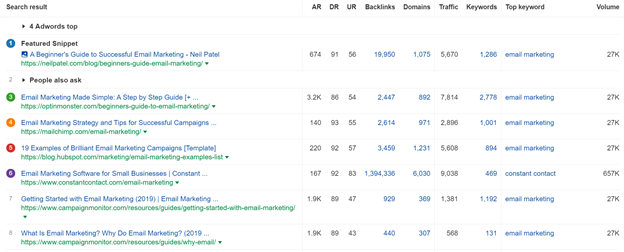
The key metrics to look at here are DR (domain rating), backlinks, and the type of content. In this example, the DR for each result is approximately the same, so in theory they all should rank alike. However, another metric – backlinks – tells a different story. Neilpatel.com and constantcontact.com clearly dominate. What’s more, Campaign Monitor themselves have two results for this keyword which could have the two pages competing with each other and possibly cannibalising results.
So the actions for Campaign Monitor here would be to review possible cannibalisation, and decide which post to build more backlinks to. It will also be important to review current content compared to competitors and see if they are missing any sections.
Brand New Website
For a company launching a new email marketing software ‘Email marketing’ would probably be an ideal keyword to rank for. But the keyword is so sought after that ranking for it will take a very long time. In the meantime you need to prioritise finding low-difficulty keywords with a reasonable search volume.
Below are two examples that this company could target in the short term. They have reasonable search volumes and ahrefs has given them a low keyword difficulty score: which means that just a few links are enough to offer a chance at ranking.

Let’s see whether a new website has a chance at ranking for “email marketing for hotels”: given that SEO is extremely competitive, it is common for big brands to go after smaller volume keywords to try and dominate everywhere they can. We can see below that some very big players with very strong DRs top search results: however, we also have a smaller player with a low DR that is currently on page 1 so there is hope!
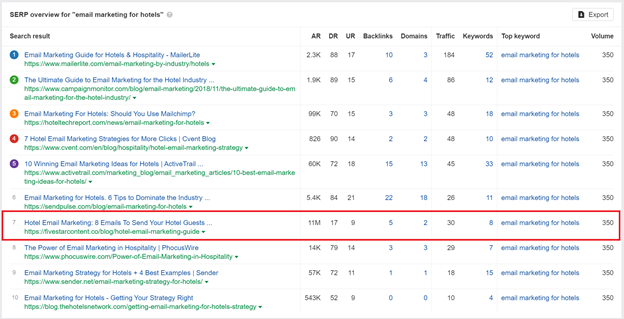
To summarise: from your original keyword list, you should prioritise and pick the keywords you believe you can rank for just as we have just done.
Step 3: Map keywords to the buyer’s journey
In this section, we’ll show you a quick way to carry out keyword research and the importance of picking which keywords to go after. You’ll also find some other handy guides if you wish to read up further on keyword research processes.
The goal of this SEO strategy is to generate leads. To do that we need to ensure we are creating content that targets and appeals to potential buyers at each stage of the customer journey. For this, we must understand ‘search intent’: in other words, we must try to understand what readers are looking for when they type in certain keywords. There are four types of search intent: informational, navigational, commercial investigation, and transactional.
So what do these four types of search intent mean and how do they align with the buyer’s journey? Let’s HotJar as an example again to classify their top keywords into each stage.
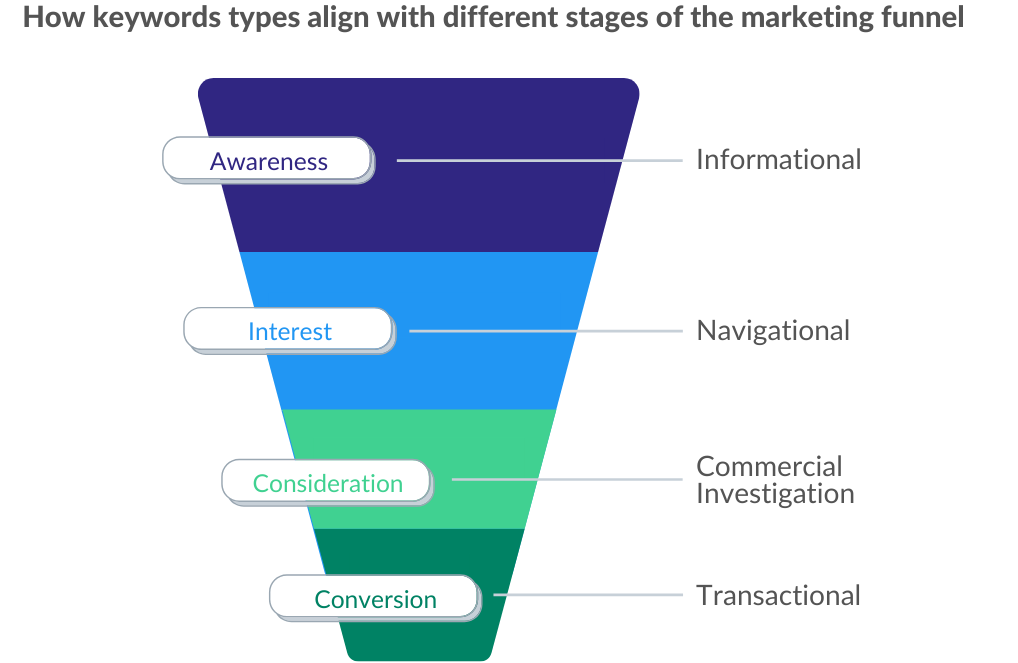
Informational — The searcher is looking to gain general knowledge on a topic, or gather more information about something. For example, “customer experience”
Navigational — The searcher knows the destination they want to reach. For example, “HotJar heatmap guide.”
Commercial Investigation — The searcher is looking to get information on something they want to buy. For example, “best heatmap tool”
Transactional — The searcher is ready to make a purchase. For example, “HotJar pricing.”
Identifying top of funnel keywords (informational)
These types of keywords will be fairly broad, with high search volume and a lot of competition. They won’t be directly what your product or service is about but it will relate to the priorities or pain points of your audiences and how you can help solve their problems.
These keywords are purely useful to get traffic to your website, fuel the funnel, and capture email addresses that can then be nurtured. Instead of going in for the hard sell on the first visit, focus on getting those visitors in your email list with relevant, useful content.
These are sometimes referred to as Shoulder Topics: they are related to your business, but not directly tied to your actual product or service. A good example of this is the HotJar customer experience guide.

This guide has generated over 1,000 backlinks, and brings in an estimated 15,000 visitors every month from organic search,
Identifying bottom of funnel keywords (commercial investigation)
Bottom of funnel keywords are used by potential buyers who are specifically searching for what you sell. For example, HotJar might consider ‘website heatmap tools’ or ‘best heatmap software’ as bottom of funnel keywords.
The SEO strategy for such keywords depends on understanding keyword intent. This is one of the most important techniques in SEO at the moment, and may require you to make some decisions that may seem counterintuitive but will yield results in the long run.
Let us say HotJar would decides to rank in position one for “best heatmap software”. A quick search of that search term shows results are dominated by listicle articles.
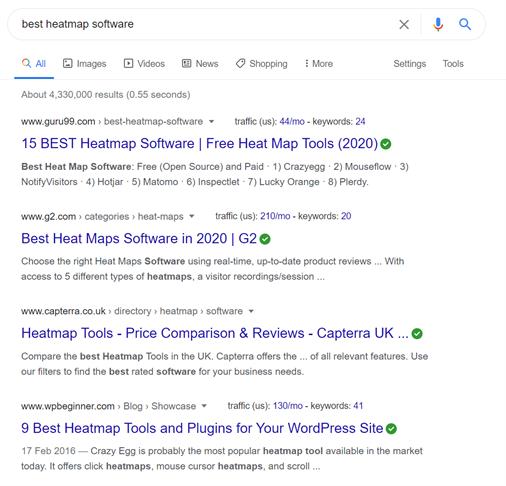
Listicles of this nature are very difficult to outrank: a more achievable goal might be to ensure you are in whatever listicle articles are currently ranking in the hope of getting some referral traffic. HotJar would be well advised to reach out to Guru99, ensure they have a G2 and Capterra profile, and so on.
Another strategy is to be creative and generate content assets that match search intent. This is what CrazyEgg and VWO, other heatmap software companies, have both done: with blogs detailing what to look for in Heatmap tools. Both these companies can position themselves within a blog as the best solution.
What is the Best Heatmap Tool For Real Results? | CrazyEgg
How To Have The Best Website Heatmap Tool? (A List for 2020) | VWO
Step 4: Plan and execute a B2B content strategy
Here we will detail the different types of content you need to be producing to start converting your traffic into leads. You’ll also find some great examples from the 3 companies we have been focusing on.
Create a resource centre
Now, what do all three of our examples have in common as part of their strategy? A quick look at their site navigation makes it evident.

Having a B2B resource centre helps establish you and your company as a helpful thought leader in your space. A resource centre is an area of your website that holds the pre- and post-sales content you create for your business. These could range from thought leadership, product information, white papers, case studies, use cases, infographics, videos, webinars, presentations and more. Built and updated properly, it can become a search and lead magnet, driving leads from the top, middle and bottom of the sales funnel to your website. Ensure whatever CMS you are using has the capability to do this, WordPress is a great choice.
Resource centres are more relevant than ever today, as we bear witness to an exponential increase in the amount of content put out by tech B2B companies in recent years. It plays two key functions in your B2B SEO.
- It houses content: Your resource centre provides you with a convenient destination to house non-commercial content so you can go after those informational keywords that can drive high levels of traffic.
- It is a source of links: Resource centres are the perfect place to store linkable assets: dense, long form assets that provide information of value. This is essential for link building. We will cover link building later on in this guide but one quick thing to understand is that without a strong backlink profile your website will never rank for your target keywords. Other websites are also not going to link to your product or service pages as they have no reason to, but if you create linkable assets they do. Typically, companies will ask leads to submit an online form with their names and work email to gain access to these assets as well.
Our three examples use this principle extensively in their SEO strategy.
The power of a great B2B blog
Businesses who regularly blog gather 67% more leads per month than those that don’t: not least because B2B blogs yield significant website traffic over time. Classifying your search keywords as we have described above will enable you to identify a significant number of informational keywords that will yield relevant and useful blog posts. And that’s not all: blogs can also generate leads effectively.
The HotJar blog brings in over 60K visits per month and over 1,000 referring domains.

The Zapier blog brings in around 650,000 visits per month, and more than 10,000 referring domains!

CampaignMonitor’s resources section brings in over 140,000 sessions per month, with almost 9,000 referring domains.

Whilst it may be tempting to go after the bottom-of-funnel commercial investigation keywords your strategy will eventually die out. You’ll run out of keywords to target, and you’ll run out of linkable assets (more on that later).
Going after the higher volume keywords that are towards the top of the funnel will allow you to expand your keyword footprint, generate brand awareness and most importantly give you the opportunity to drive visits to your website each month.
Example in action
The CampaignMonitor URL below is responsible for driving an estimated 87K visits per month. That’s over half their organic traffic according to Ahrefs.

You can see some of the keywords they are ranking for below. All the blogs and keywords are very broad and informational, and probably won’t trigger a request for a demo. But that’s okay, as that is not the purpose here. The main goal is to fuel the funnel.
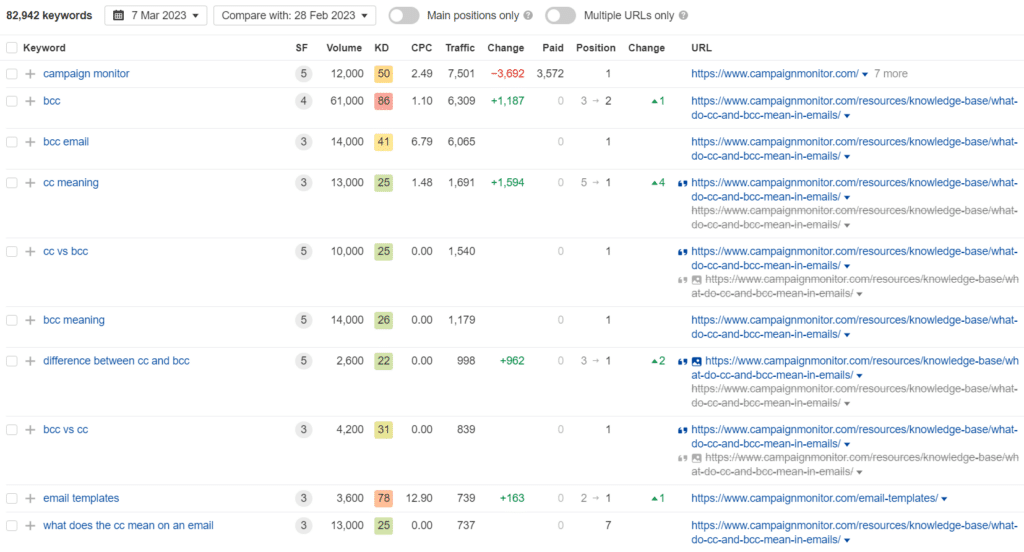
This type of content allows CampaignMonitor to showcase its expertise and provide helpful information to searchers. The search terms are relevant to email so we know the person is potentially using email to communicate with subscribers so they could eventually need a new solution. Once a user lands on the page this opens up a world of opportunities to drive leads. Campaign Monitor provides a subscription call to action on the page and even recommends other resources that the user may find useful.
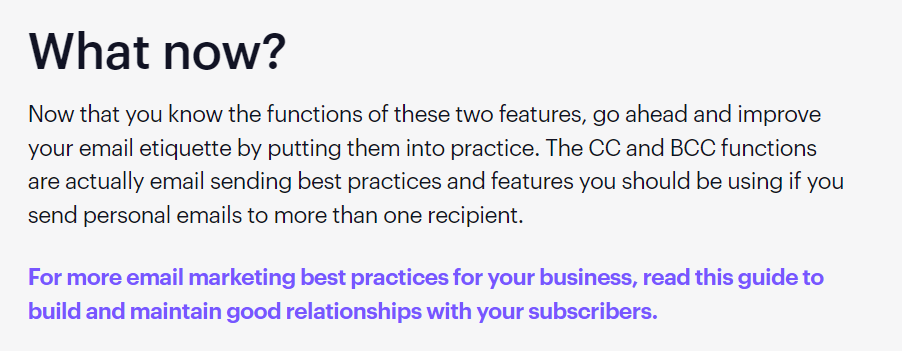
Optimise your blog titles
No matter what industry you are in, the enormous volume of content on the internet ensures that the topic you’re writing about will likely already have been covered. If your content is already ranking you should aim to test and tweak your page titles as these can have a major impact on click through rates.
For example, one of HotJar’s informational and large volume keywords that drives a lot of traffic for them is “marketing research”. You can see they take their page titles seriously by looking at the example below.
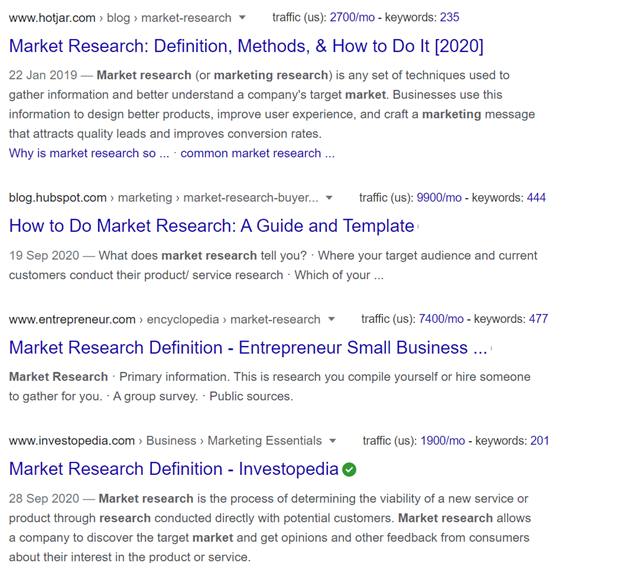
When you compare that page title to the others ranking for the keyword, you can see it is compelling, clearly articulating what the reader can expect to get, and showing that it contains up to date methods. Page titles are easy to test and monitor the impact of changes. For example, using power words, including dates, or words like ‘Guide’ or ‘Template’ work well.
Optimise your product and service pages
Your product and service pages are where you need to sell your products in the most compelling, effective way possible. This is your chance to showcase your product or service to potential customers and show them why they need to hit that demo or free trial button.
People typing in considerational keywords such as “HotJar pricing” or “CampaignMonitor demo” will be directed here, so you need these pages to contain all the information to address any customer questions.
The HotJar pricing page does exactly this. It recommends the best package for you based on how many page views you want to track, details the core features of the product, and even includes an FAQ section.
CampaignMonitor’s pricing page also contains a lot of useful information that can help potential buyers see exactly what they will get. Pricing is clearly visible, features for each plan are detailed, and again, there is an FAQ section.
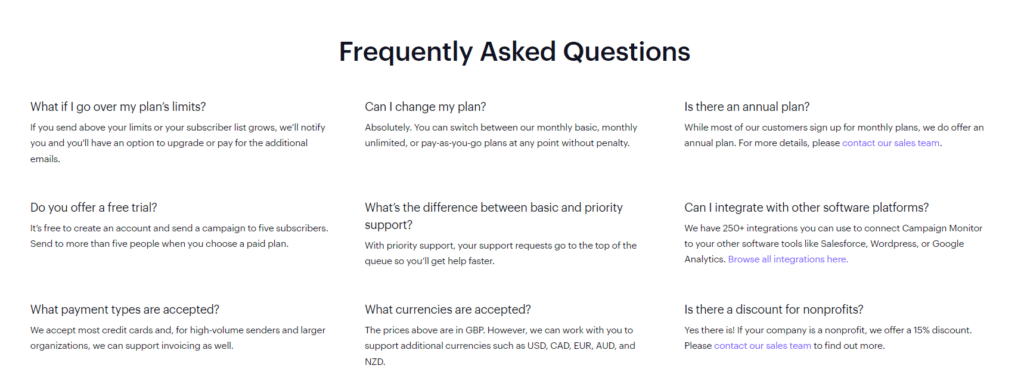
A few tips to make these pages work well are
- Use social proof, reviews, awards and testimonials to provide assurance. Video testimonials or case studies are even better!
- Have clear CTAs – whether it’s a free trial or demo
- Be clear with service / pricing levels
- Ensure the content on the page details exactly how you can address customers’ pain points
Step 4.1: Create different types of content
Here we will detail the different types of content you need to be producing to start converting your traffic into leads. You’ll also find some great examples from the 3 companies we have been focusing on.
Case studies
What’s the best way to convince a potential customer you are the right choice for them? Case studies. One of the oldest but best forms of social proof for B2B – in a survey we conducted last year, tech B2B buyers were unequivocal that they valued case studies more than any other type of content.
People don’t like being sold to, but people do like stories. They are easy to connect with and are a great method of storytelling. Nothing is better than having a data-backed case study showing how you helped other people overcome the same problem your current prospects are facing.
Here are 4 quick reasons why you need to be making case studies.
- Industry specific – Case studies allow you to focus on a specific goal or outcome that’s related to your product or service offering. So they are guaranteed to resonate and impress your target market.
- Positions you as trusted suppliers – Case studies are built on actions, outcomes and researched conclusions so they are effective in positioning you as trusted partners or other companies like you reader.
- Shows how problems are solved – They demonstrate that you can deliver on the promises you make on your website, allowing potential customers to understand “why” and “how” your solution is the best.
- Lead generation – Case studies support lead generation and should be strategically used throughout your website, not just on a specific page. For example, if you have a high traffic blog on a certain topic, a case study related to that topic is perfect for inclusion within the blog.
Here are some case studies that HotJar uses.
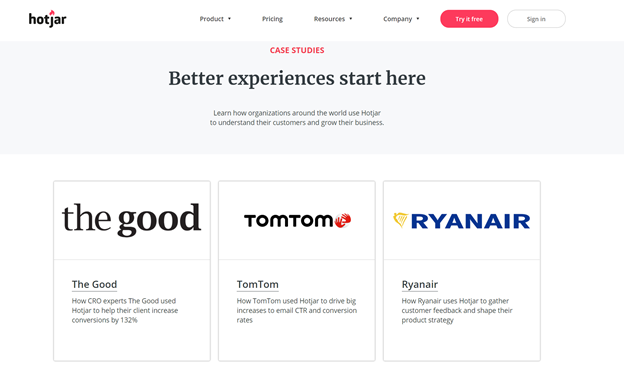
Video
Video has grown in importance over the past few years and it’s a great medium to engage with your audience. If used correctly, video can be an extremely powerful form of content and make a significant contribution to your overall SEO strategy, in more ways than one.
In fact we have our own research to back this up. We surveyed over 100 B2B buyers on what type of content they found most useful when considering a new purchase, 53% of respondents said that video was the most useful form of content.
Zapier uses videos effectively to demonstrate what its products can do, and position themselves as helpful experts, with content that is useful for both customers and prospects.
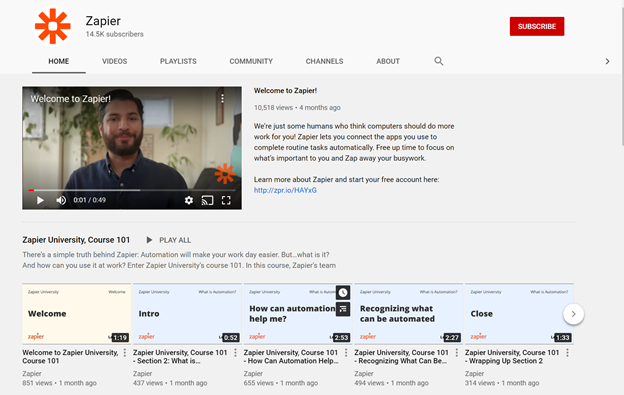
eBooks
eBooks are great to use as gated content for lead generation. The most important thing here is to make eBook content as compelling and actionable as possible.
HotJar has used these to great effect. The popup below converted 408 visitors in the first three weeks, 75% of which were new prospects.
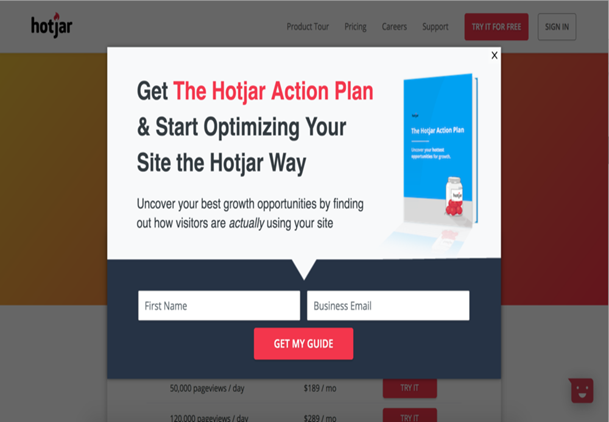
You can then segment these users in your CRM and run nurture campaigns for them. In this HotJar example, prospects received an email with the ebook as a PDF, along with an offer to try out Hotjar for an extended period of time.
This is what the actual email looked like to non-existing customers
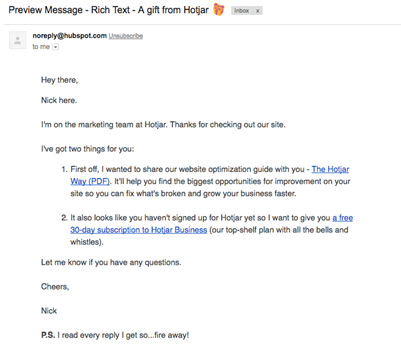
White papers
White papers are a powerful tool in the thought leadership arsenal: one study found 60 percent of respondents said white papers are a valuable way to generate new leads. A high-quality white paper gives you the chance to retain the attention of your target audience, build trust and credibility, and move leads through the funnel. DemandGen’s 2017 Content Preferences Survey found that 76% of buyers would submit personal information in exchange for white papers.
Expert guides
An expert guide, unlike a white paper, focuses on the solution or service that you offer, and provides actionable advice to enable customers to achieve the benefits. Similar to white papers, these guides can be offered as PDF downloads, like this example on the Brian Deans blog:
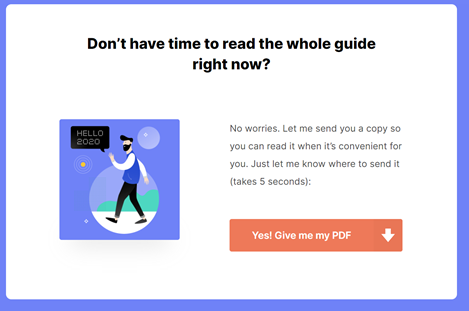
Again this is a quick and easy way to show your expertise and quickly drive leads.
Newsletter sign ups
A strong email list is a central component of any B2B marketing strategy. With long purchase cycles, nurture e-mail campaigns allow you to stay in touch with prospects who have shown an interest. Make it easy for your users to sign up to your newsletter by placing sign up boxes throughout the content.
HotJar and CampaignMonitor include newsletter subscription boxes throughout their content and even offer social proof, showcasing how many subscribers they have.

Newsletter sign-up boxes work well at the end of the blog, with the message that users should not miss further updates. You can also set pop up timers to appear once someone has been on a piece of content for a particular amount of time.
Step 5: Implement an ongoing B2B link building campaign
Backlinks are one of the most important parts of a successful SEO strategy. In this section we’ll breakdown why you need to build backlinks and detail 6 ways in which B2B websites can successfully build quality backlinks.
One of the most important aspects of an SEO strategy is building backlinks to your website. Without building any you will not be able to improve your ranking positions, it’s as simple as that.
A study by Brian Dean found that pages with the highest number of total backlinks tended to rank best in Google. In fact, he found that the #1 results had on average 3.8x more backlinks than the results rankings #2 – #10.
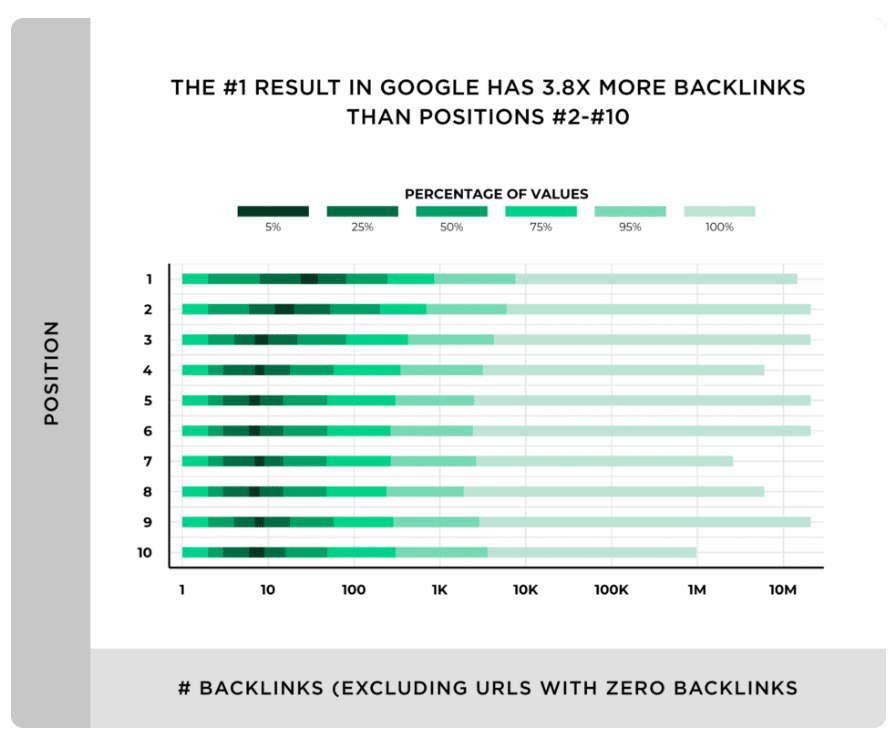
However, the key here is how you build these links and what type of websites they are on. You can think of a link as a vote of confidence for your website and its content in the search engine’s eyes. If a reputable website links to yours, they are saying they trust and back your content and expertise in a particular subject.
The more votes you have, from different websites, pointing to the same page, the more search engines can trust that your content is worth linking to. They therefore also start to think it’s worth showing in search rankings. So, it’s safe to say backlinks can have a positive effect on your website’s ranking position or search visibility.
When deciding what content should rank, search engines will look not just at the number of links pointing to web pages from external websites: they will also consider the quality of those websites. So let us qualify our statement above by saying that the more high-quality websites that link to you, the more likely you are to rank well in search results.
Now let’s cover ways in which you can start building backlinks to your website.
There’s a lot more that can be said about link building.
If you’re interested, you can find out more on the guides below.
6 ways B2B websites can build backlinks
1. Free tools and calculators
Free tools can work very well in the right industry; you just need to have the right idea. Free tools also fit into the linkable asset category we have mentioned throughout this guide.
People will be more willing to link to these pages as the tool will be useful, it may have helped them so they feel the need to reciprocate or share, and it’s not a service/product page that you can make money directly from.
The best example is HubSpots Free Email Signature Generator. This tool is one of HubSpot’s most linked-to pieces of content across their entire website and brings in a high amount of traffic each month.

HubSpot’s Blog Ideas Generator is even more effective in this regard.

If you’re considering building a free tool for leads or link building the key is to understand what your audience wants to know and structure your tool around this.
2. Original research
Original research is a great way to build backlinks to your website and potentially drive traffic. CampaignMonitor do this very well, mining the data they collect from the millions of emails sent per month from their platform. From this data they created a benchmark report detailing average open rates, click through rates by industry and even day. It’s the perfect data for anyone who works in the email industry and is looking to improve their email marketing campaigns.
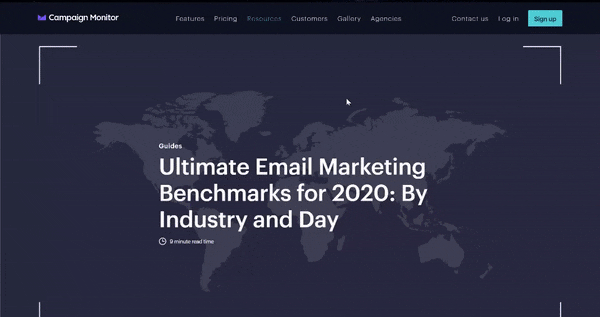
Below, we can see how well that research has done, driving over 2,000 backlinks to CampaignMonitor and ranking for over 1,000 keywords.

Now you may not have access to all the data that CampaignMonitor does, but don’t let that put you off. Getting the data you need can be done on a small budget. In fact, we ourselves have also had success using this method.
We surveyed over 100 B2B buyers on how content can influence their purchasing decisions. Not only was this a good insight for us as a business, but it provides us with some unique data that we can outreach with. Whilst this isn’t on the same scale as CampaignMonitor it has worked very well for us, driving over 96 backlinks from 58 domains.
3. Guest posting
Guest posting was a backlink tactic that saw a real boom a few years ago, which has since petered off. But guest posting is alive and well – it is just being done in a more considered, strategic manner.
To use guest posting effectively and avoid the risk of being penalised by Google you need to find high quality websites in your industry / sector and pitch them content ideas, not unlike what a PR company does. There are certain ways you can find these websites, for example lists like this one of websites that accept guest posts.
You can also use search operators to find guest posts and other link building opportunities. Just replace the keyword with your chosen topic.
For example: email marketing inurl:write-for-us.
‘keyword’ inurl:write-for-us
‘keyword’ intitle:”write for us”
‘keyword’ “Guest Post Guidelines”
You can then go through these results, evaluate the websites and pitch them some topic ideas. You need to bear in mind that your competitors can also do the exact same process here, so whilst building these links will be good you’ll need to combine them with other tactics to truly set your backlink profile apart.
4. Unlinked brand mentions
For certain well established brands, people may be writing about you without linking to you, as shown in the example below. Finding unlinked brand mentions and requesting a link can be a simple and successful link building tactic.

The process here is simple, just find unlinked mentions and contact the website owner and ask for a link to be added. As they already trust your data or content enough to mention you, they might be likely to add a link.
Finding these opportunities can take time and you may need to invest in a tool that can help you do this tactic more effectively. Here are some guides that might be useful:
SEMrush – https://www.semrush.com/kb/1064-how-to-convert-unlinked-mentions-into-backlinks
Ahrefs – https://ahrefs.com/blog/unlinked-mentions/
BrandMentions – https://brandmentions.com/blog/unlinked-brand-mentions/
BuzzSumo – https://buzzsumo.com/blog/simple-tip-gained-us-200-backlinks/
5. HARO
HARO is a great free resource that can help you build some very powerful links. You can sign up for a free account and will then receive 3 emails a day with potential opportunities. HARO can put you in contact with some of internet’s major publishers that are looking to quote experts in articles they are writing. An example email is below.
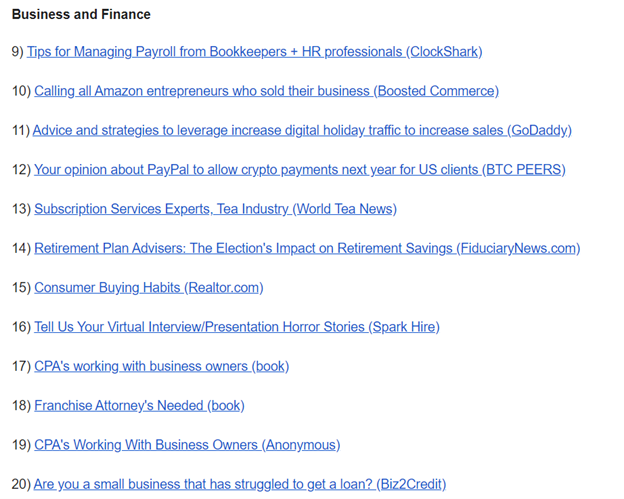
So for example, a bookkeeping company might wish to featured in an article with ClockSharke (no.9). You simply need to click that link and it will take you to a more detailed description of what’s required from the author.
6. Podcasts
Podcasts have boomed over the past couple of years so no matter what industry you’re in chances are there will be one. All of the 3 examples we have looked at so far will be used by those in the world of digital marketing, so a quick search for “digital marketing podcasts” and we can already see a plethora of great opportunities.

So do your research, have a listen to a few of the podcasts that you find and then pitch your idea for a topic to talk about.
Step 6: Keep up with technical optimisations
In this section, we’ll detail some technical SEO factors that you need to be aware of and stay on top of. Techincal SEO is often overlooked in a SEO strategy but issues here can really hold your website back.
The third and final pillar to our B2B SEO Strategy is focused on the technical side of SEO. This part can often be overlooked but the impact technical work can have on a website is extremely significant.
In the most basic terms, technical SEO involves improving all technical aspects of your website to help it rank higher in search results. It is a broad field, including:
- Sitemaps
- Crawling and indexing
- Mobile optimisation
- Site speed
- Site structure
- URL Structure
- SSL certificates
- Image optimisation
- Internal and external links
- Canonical URLs
Utilise Google Search Console
Google Search Console is an often overlooked SEO tool but it can provide valuable insights and flag critical SEO issues. Once Google has crawled and indexed your website you will be able to see what issues it has found in a coverage report like the one shown below.
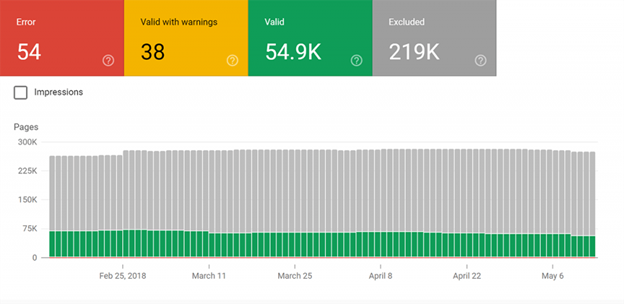
You can then click into each section and see what errors your website has, and what URLs are causing you issues. For example if we were to click errors within the coverage report it would take us to a screen like the below.
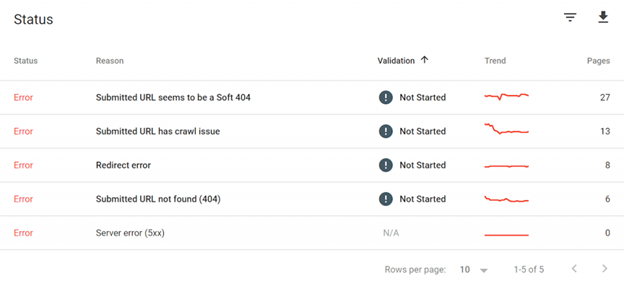
You can then go into each error and see what specific URLs are causing you these issues and address them.
Make sure all pages are HTTPS
Google confirmed back in 2014 that SSL certificates, also known as HTTPS encryptions are now a ranking signal.
Your website should already have this in place as a standard practice now but it is an important aspect that’s worth noting.
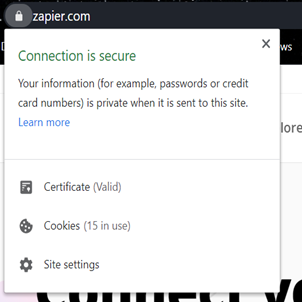
Ensure all your pages are mobile friendly
57% of all web traffic is from mobile devices. Potentially more than half of your customers finding your and considering you on a mobile device, what type of user experience are you giving them?
Use Google Mobile Friendly Test to check your key pages. You should also get alerts from Google Search Console if a page is deemed to have mobile issues.
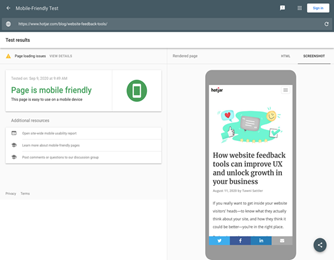
Improve page speeds
The one thing that all SEO experts agree on is that page speed matters. This is a technical SEO aspect that you simply can’t afford to ignore. Even if your content is the best piece that has ever or will ever be written on a particular topic, your ranking potential will be limited if the page loads slowly. Not only is a slow page bad from an SEO perspective, more importantly it is bad from a user experience point of view. If a page struggles to load within the first few seconds that user will be gone just as quickly as they came.
Numerous free tools provide a lot of useful information and recommendations to improve your page speed. Here are just three:
A few simple techniques to speed up your website include:
Optimise images – Check all your images are compressed and are in a format like JPG in the majority of your posts. Use a tool like TinyPNG to further compress the image files.
Enable browser caching – Temporarily store some data on a visitors’ computer, so they don’t have to wait for it to load every time they visit your site.
Enable compression – Enabling compression on your website can significantly reduce HTML and CSS files and increase site speed.
Reduce server response time – Google recommends keeping server response time under 200ms.
Use a Content Delivery System (CDN) – Try using a CDN like Cloudflare to increase your site speed.
Monitor core web vitals
The two factors above will also help improve your core web vitals, which will become very important from 2021 onwards as Google plans to make these a confirmed ranking factor.
You can find your core web vitals within Google Search Console, with the caveat that fairly low traffic websites may not be able to get all the data. However, if you can see these you’ll be able to quickly identify what URLs need your attention and for what issue. These can change over time as well as they are based on real user experiences.

Three main factors make up core web vitals.
Three main factors make up core web vitals.
1. Largest contentful paint (LCP)
Essentially this is where page speed comes in. Largest contentful paint (LCP) basically asks, how fast does the page load? The main thing Google is looking at here is the largest item in the viewport (desktop or mobile). Whatever the largest piece of content is, if it’s an image, video or text, how fast does that take to load? If it’s too slow, it will be deemed a poor URL.
2. Cumulative layout shift (CLS)
With cumulative layout shift (CLS) Google is asking: ‘how fast is the page stable’? The principle is that users should not have an experience where a page has loaded, and at the last second something in the page layout unexpectedly shifts, causing errors like the wrong button being clicked, for instance.
The example below illustrates this:
This type of poor user experience and will be very annoying to visitors. Google doesn’t want that.
To optimise in this regard, you need to ensure that the page becomes stable quickly by stopping any shifts and ensuring that image sizes are defined. So if you have an image and it’s 400 pixels wide and tall, those need to be defined in the HTML.
3. First input delay (FID)
The third and final factor influencing core web vitals metrics is first input delay (FID). This factor seeks to check how quickly the page reacts to user input. For example, when a user clicks on a button or a JavaScript event, how fast does the browser process and complete that action? It is considered a poor experience when users click on something and nothing happens or response is very slow. For important pages such as a login or sign up page, or other pages where users will be clicking on things, FID is very important.
FID is mainly influenced by JavaScript and third-party code so those are the first two places to dig into if you find any issues here.
Regularly crawl and fix issues on your website
To spot and keep on top of all these technical SEO factors the best approach is to invest in a good crawler, or have experts audit your site regularly. These SEO crawlers will go through your website the same way Google does, flagging issues as they spot them. There are plenty of options to choose from, some more expensive than others. Our picks are below:
Deep Crawl: Deep Crawl is a well known crawler that can provide you with insights on SEO health and viability. Each crawl will provide you with a to do list of required improvements and errors. It will easily spot issues such as: duplicate content, broken pages, flawed titles, descriptions and metadata. It’s quite expensive though so probably best for those seriously investing into SEO.
Screaming Frog: One of the simplest and probably best known crawlers in the SEO world. It can seem a little daunting and the user experience isn’t as good as DeepCrawl or Sitebulb but you get all the same information. Once you get familiar with the way it works it really is all you need. There’s also a free version which is perfect for smaller websites.
Sitebulb: Sitebulb has won multiple awards and has a very good reputation within the SEO world. Similar to DeepCrawl, it details a site’s technical problems in simple language, and explains exactly what you need to do to fix them. SiteBulb also has a complete knowledge library explaining every issue that it has flagged so you can understand problems and how you can fix them.
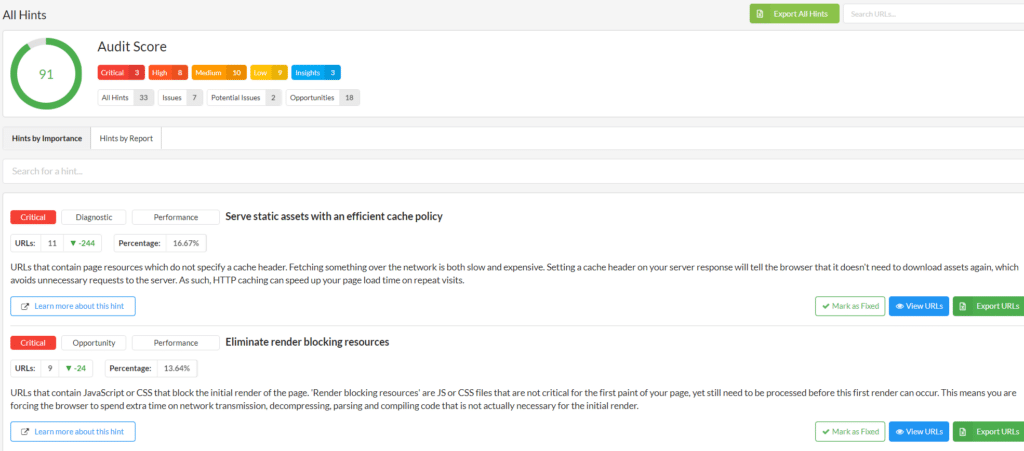
Spotting and fixing these SEO issues is good housekeeping from a technical SEO perspective and can have a significant cumulative impact over time.
And finally: Have patience
Finally, the most important thing to have within a B2B SEO strategy is patience. Even if you have significant budgets to invest in expertise and tools, results take time. If you’re starting from scratch they will take even longer but SEO is about playing the long game.
If your strategy or SEO package has all the above and focuses on the 3 core pillars of technical SEO, content link-building, your traffic from organic search will inevitably rise. You may even be able to build your organic traffic to potentially very high levels (depending on your industry) like HotJar, CampaignMonitor and Zapier have done.
Have patience, monitor work done, track your results, and stick with it. Your sales pipeline will thank you for it.
Fill out the simple form below and we will be in touch within 2 business days
Get in touch and let’s start a conversation about how an Isoline Communications content marketing strategy can improve your ROI
